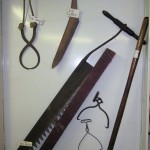The bitter cold weather we experienced a few weeks ago didn’t seem good for doing anything outside. But 100 years ago it would have been perfect for producing a summertime necessity: ice!
Until mechanical refrigeration in the home became commonplace in the early 20th century, housewives kept their food preserved and their lemonade cold with ice harvested during the cold, winter months. Harvesting ice for cooling dates back to the ancient Persians who brought ice down from the mountains in winter and stored it in heavily insulated, underground vaults. Europeans, Russians and even the Chinese also enjoyed harvested ice although this luxury was often reserved for the wealthy. In the United States the ice trade took off at the beginning of the 19th century with the development of icehouses and ice boxes. Many northern communities along the east coast spent the cold, winter months harvesting ice from lakes and rivers and storing it in well insulated ice houses. In the summer this ice was not only used locally but shipped to the Caribbean and southern states.
Harvesting ice was often a community event. When the weather had been cold enough for a sufficient time to build up 10-14” of ice, men would gather to begin the harvest. A depth of 10-14” of ice was necessary to hold the men and horses used in the harvest. The first step, after determining depth, would be to scrape off any snow on the ice. A wooden scraper sufficed to remove light, powdery snow but a scoop scraper was often needed to remove deeper, wetter snow. After the surface was cleaned the ice would be scribed in a checkerboard pattern with an ice marker. An ice marker had a row of teeth about 20” apart which cut an inch or two into the ice. It also had a guide on one side which fit into the previous groove to keep the lines parallel and straight. After the pattern was established an ice plow pulled by a horse was used to deepen the depth of each grid line. A pass with the ice plow deepened the grid line by up to two inches. Horses wore studded shoes to keep their traction on the slick surface. A few passes by the ice plow cut into the ice 6-8” whereupon the horses gave way to men with ice saws. A few strokes with the ice saws freed the blocks of ice which were floated to a waiting conveyor to be loaded onto wagons. The ice blocks were moved up the conveyor by men with pikes or by horsepower. Once loaded, the wagons headed to the icehouse. The ice house was typically a wooden structure with double walls that were packed with sawdust for insulation. The walls could be as much as three feet thick. To fill the icehouse you started with a layer of insulating sawdust on the floor. As you stacked the ice you put a thin layer of sawdust between each layer so you could get it apart when you needed it. When the icehouse was full you covered the top layer of ice with a heavy layer of sawdust. When summer rolled around the ice was delivered to homes and businesses by the iceman but we’ll tackle that topic when it gets a little warmer outside.
Most communities along the Miami and Erie Canal used this same procedure to harvest ice from the canal when it froze in the winter. In Delphos the Fisher Quarry was also flooded in winter for ice harvesting. Fifty to one hundred men were used to harvest the ice from the quarry using Gifford Brothers Ice Elevating Machinery to put the ice into the company’s spacious icehouses. Several smaller icehouses show up on the Sanborn Fire Maps of Delphos from 1884 to 1911, all within a block or two of the canal. Included in that number is an icehouse along the canal behind the Postal Museum, at the rear of Cliff’s Small Engine, a block west of the canal on an alley between Second and Third Streets, at Main and First Streets and next to the canal between Eleventh and Twelfth Streets. There was also an ice pond and icehouses at the Steinle Brewery on East Second Street.
A display of ice harvesting tools can be seen at the Delphos Canal Commission Museum. And a very cool video of a 1919 ice harvest at Pocono Manor in Pennsylvania can be found on the Delphos Canal Commission Facebook page.














Speak Your Mind